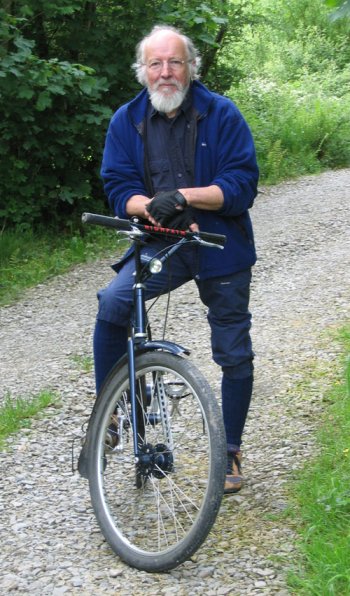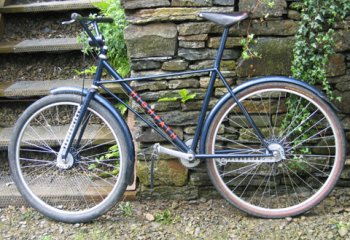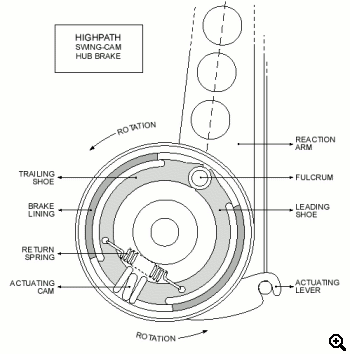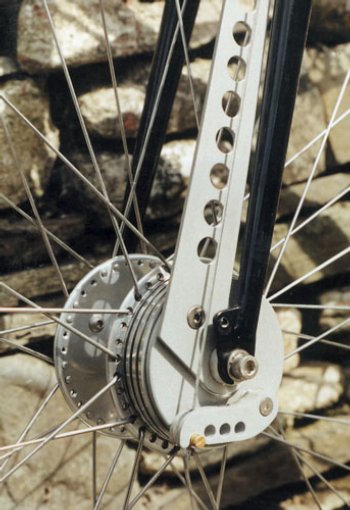[ 63XC.COM | STORIES | WRATH-SHARMAN ]
David Wrath-Sharman talks hub brakes
63xc.com: I guess we'd better begin by talking about your background. In the early 80s, you were part of a gang of people who really kickstarted mountain biking in the UK: you, Geoff Apps, a couple of others... You were making UK mountainbikes that were very different from the US ones. DW-S: There were a couple of people making lookalikes -- bikes that were very similar to the US ones. Geoff and I started from very different places. Geoff came from a traditional roadster background. I started off from my old fixed wheel track bike, with a high BB and really short back end. Geoff was probably the first to market with his Cleland Aventura. Highpath, my company, got going soon after.
63xc.com: Tell us more about your experiences before you got into biking. You were a sculptor, I believe. DW-S: I've done lots of different things. I trained as a sculptor and a studio potter. I've done cabinetmaking, enamelling, jewellery, sheet metalwork, engineering... 63xc.com: That kind of small workshop experience feeds well into bicycle work. DW-S: Also, I played around with cars a lot. In the late 70s I was restoring classic cars -- Alfa-Romeos mainly, which tend to turn up with lots of parts missing. I had to design and make the components. When I got into bicycles, the mindset was still there: if it isn't around, make it. That's how I made my own bottom brackets and hub brakes and other parts. I never made a bike without a set of my own hub brakes. 63xc.com: So, what appeals to you about hub brakes? Presumably a major consideration is the fact that the mechanism is protected from wear and exposure. That's a big plus in the UK's damp climate. DW-S: That's right. I don't have much experience with disk brakes, but I gather that pads wear out quickly. Well, the hub brake on my personal bike has probably done 20,000 miles, and I'm just getting round to replacing the shoes. 63xc.com: That's motorcar mileage. DW-S: And, when it does go... the shoes in mine used to cost £3.80. Probably about £7.00 today. 63xc.com: How about control? DW-S: A good hub brake offers great control. Very easy to modulate, no grabbing. You can brake on ice. Generally they're dry inside, so they're very consistent. 63xc.com: A couple of builders like Matt Chester don't like disk brakes, because of the stresses they build into the frame. How do hub brakes compare? DW-S: Well, the big difference with a hub brake is the reaction arm. This is mounted on the axle at one end and the forks or frame at the other and takes all the braking loads.I designed my hubs with very long reaction arms which go right to the top of the forks or right up against the bottom bracket. That allows the fork to react exactly as it would with a cantilever setup. 63xc.com: Presumably, the longer the arm, the less stress in the frame? DW-S: Yes. If you know what you're doing, you can have a very light frame with hub brakes. 63xc.com: How about the impact of hub brakes on wheelbuilding? DW-S: Because of the large size of the brake pan, you end up with very large diameter flanges which can be best built 1x, giving you a much harder, lateraly stronger wheel. 63xc.com: What's on the market? I'm aware of Arai drum brakes, Sturmeys, the VT series, and the Sachs ones -- which, like all Sachs products, look suspiciously like Sturmeys. DW-S: There's also the Shimano rollercam brake. I haven't had a chance to look at it, but I gather the action is rather rough. 63xc.com: The Arais you just jam on at the start of downhills as a speed retardant. They're not really for bike handling. What do you think of the Sturmey? DW-S: I couldn't answer for the latest ones. The older Sturmeys used to work better than the Sachs, which squealed. They had better linings, and I found that they'd work even with water in the casing -- not true of Sachs. 63xc.com: Someone told me that Sturmeys had asbestos in the lining. DW-S: They never told me what it was, but it was a non-asbestos lining. Of course, now they're made in Taiwan, I've been told that they're not as good as they were. But even when they were built in the UK, they didn't work that well. They were OK for shoppers and general purpose road riding, but not for offroading, stopping on 45 degree slopes and so on. 63xc.com: But I remember seeing Sturmey hub brakes on a Highpath. What happened to that idea? DW-S: Once upon a time, long ago, Sturmey realised that there were things called mountainbikes and that hub brakes would be a good idea. So the sales director and a sidekick put hub brakes on a mountainbike and went off into the wilds. Nearly killed themselves. The brakes weren't good enough. I got roped in as a design consultant, and I redesigned the innards. I still have some, and they really work, but Sturmey didn't go ahead. They told me they were making enough money with the hubs they already had. 63xc.com: Very Sturmey. DW-S: Very English, unfortunately. 63xc.com: Why are yours better? DW-S: The mechanism that I use makes the hubs self-compensating, so that you always have consistent braking, starting at 1%. 63xc.com: How does that work? Actually, before we get to that, we'd better establish how a basic setup works. I can imagine the inside of the shell of the hub. Presumably, when you brake, a mechanism presses metal objects -- shoes -- against the cylinder walls to create friction and slow the wheel. Now, those shoes are anchored at the axle? DW-S: No, they're completely free of the axle. They're anchored to a fulcrum which is anchored in turn through the the back plate to the reaction arm. 63xc.com: The back plate being one side of the hub? DW-S: Yep. The part that closes off the hub. And the thing that pushes them out against the walls is the cam. There are a number of different ways of placing the shoes, but the usual arrangement is to have a 'leading' and a 'trailing' shoe -- one ahead of the fulcrum, and one behind it. That's the way that Sachs and Sturmey do it. It's mechanically simple, and it means that the brake works whether the wheel is rolling forwards or back. 63xc.com: OK. DW-S: Now, here's the issue with those designs. During braking, the forward rotation of the hub will push the leading shoe against the fulcrum, tending to apply it harder. We call that self-servoing. By the same token, rotation will pull the trailing shoe off the fulcrum and down onto the cam. The leading shoe, which is doing more braking, wears faster. As it wears, the cam tends to act on it less, and it takes more lever pressure to get the brake working. Eventually it becomes impossible to make the leading shoe self-servo, all the lever pressure is wasted in the trailing shoe, and the braking power is drastically reduced. 63xc.com: Presumably this is where your swing-cam design comes in? DW-S: I was familiar with various cable-operated hub brakes from classic cars. Alfas have huge 14" ones - they don't work very well either! Whereas my little Austin A40 had 8" diameter hubs that worked fine. Hydraulic, you see. This is the big difference. 63xc.com: But your brakes aren't hydraulic. DW-S: It wasn't necessarily the hydraulic action which made the difference. Rather, it was the way the hydraulic mechanism could always apply pressure to the shoes equally regardless of the amount of wear on them. There was another lead, too. The LeLeu hub brakes that were fitted to the Clelands worked better than anything else on the market, even though they were of appalling quality -- narrow, thin flanges, awful cup and cone bearings -- really cheap. But to get over manufacturing tolerances the cam was held approximately in place by a thin plate slotted and riveted to the back plate. So the cam found its own position and continued to do so. It worked most of the time but tended to be a bit erratic. So the trick was to invent a simple cable operated mechanism that mimicked the hydraulic brakes and was smooth and reliable, then build that into a bombproof cassette bearing hub. In my swing cam brake, the whole of the back plate is mounted on the axle and allowed to turn, and the cam is fixed to that. As the leading shoe wears, the backplate and cam follow it around. You can always brake powerfully, right up until it's worn out. 63xc.com: Is the swing cam in production right now? DW-S: No. People fell in love with disk brakes. It became so universal that it wasn't economic for me to carry on. I think that's changing. People have realised that disks have problems: vulnerability, thief magnetism... All of a sudden, people are asking me for hub brakes. 63xc.com: Could you get back into production? DW-S: I have a couple of people that I can approach, either to make the hub or to supply castings. It's the liner that's the problem. My own brakes were cast and then turned. Out of a batch of 50 there'd be maybe 30 that I could use, so the costs were high. For a while I was able to get castings from Sturmey and I churned out modified Sturmey hub brakes, but their stock 70mm design isn't really big enough for offroad. You need an 80mm. I did try to compensate using twin-70mm designs which worked almost too well, but they were heavy and they needed a 120mm drop out width at the fork -- fine if I'm making the bike, not otherwise. 63xc.com: Who has expressed interest? DW-S: I think the market is among workbikes, courier bikes, and a particular cadre of mountainbikers. 63xc.com: I think fixers might figure here.
DW: I would have thought a single 80mm front hub brake on one of your fixed wheel bikes would make for a very simple, discrete and maintenance-free machine. 63xc.com: I agree. I'd love to try it. Thanks Dave. DW-S: You're welcome! Think I'll make one for myself...
[ TOP ] |
Date
v1.0 written May 2006
Related
Dave Wrath- Sharman still works with Highpath in Wales.
Mailing list
Join the 63xc.com list.



